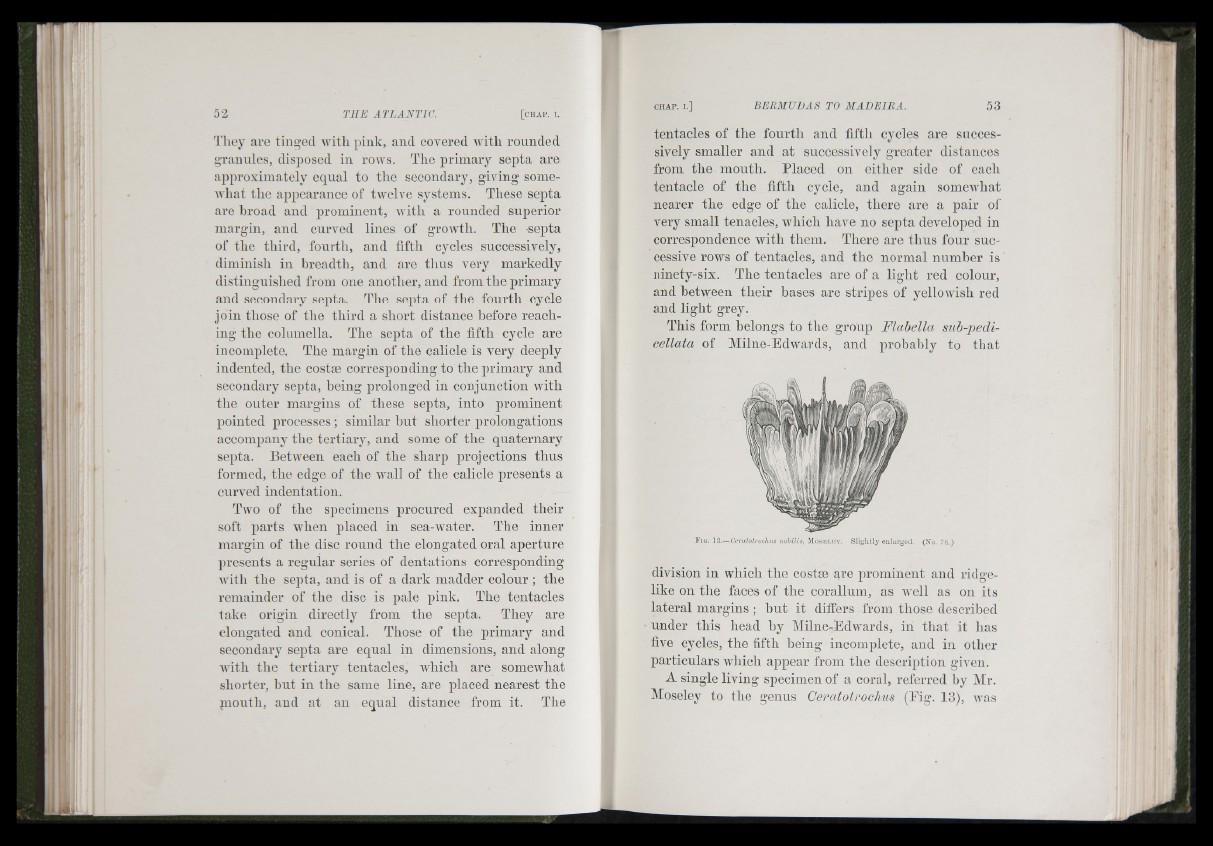
They are tinged with pink, and covered Avith rounded
granules, disjiosed in rows. The primary septa are
approximately equal to the secondary, giving some-
AA'hat the appearance of tAvelve systems. These septa
are hroad and prominent, Avith a rounded superior
margin, and curved lines of groAvth. The septa
of the third, fourth, and fifth cycles successively,
diminish in breadth, and are thus very markedly
distinguished from one another, and from the primary
and secondary septa. The septa of the fourth cycle
jo in those of the th ird a short distance before reaching
the columella. The septa of the fifth cycle are
incomplete. The margin of the calicle is very deeply
indented, the costai corresponding to the primary and
secondary septa, being prolonged in conjunction with
the outer margins of these septa, into prominent
pointed processes; similar hnt shorter prolongations
accompany the tertiary, and some of the quaternary
septa. BetAA^een each of the sharp projections thus
formed, the edge of the wall of the calicle presents a
cuiwed indentation.
Two of the specimens procured expanded their
soft parts when placed in sea-Avater. The inner
margin of the disc round the elongated oral aperture
presents a regular series of dentations corresponding
A\fith th e septa, and is of a dark madder colour ; the
remainder of the disc is pale pink. The tentacles
take origin directly from the septa. They are
elongated and conical. Those of the primary and
secondary septa are equal in dimensions, and along
Avith th e te rtia ry tentacles, AAdiich are somewhat
shorter, h n t in the same line, are placed nearest the
niontli, and at an equal distance from it. The
tentacles of the fourth and fifth cycles are successively
smaller and at successively greater distances
from the mouth. Placed on either side of each
tentacle of the fifth cycle, and again someAAdiat
nearer th e edge of the calicle, there are a pair of
very small tenacles, which have no septa developed in
correspondence with them. There are th u s four successive
rows of tentacles, and the normal number is
ninety-six. The tentacles are of a light red colour,
and between th e ir bases are stripes of yelloAvish red
and light grey.
This form belongs to the group Flabella sub-pedi-
cellata of Alilne-EdAvards, and probably to th a t
Fig. Vi.—Ceratotrochus nobilis, Mos el ey. Slightly enlarged. (No. 78.)
division in which the costae are prominent and ridgelike
on the faces of the corallum, as Avell as on its
lateral margins ; h u t it differs from those described
under this head hy Alilne-Edwards, in th a t it has
five cycles, the fifth being inconi]ilete, and in other
particulars Avhich appear from the description given.
A single living specimen of a coral, referred by Air.
Aioseley to the genus Ceratotrochus (l^ig. 13), Avas